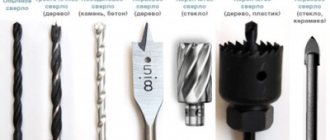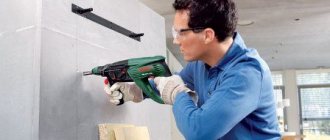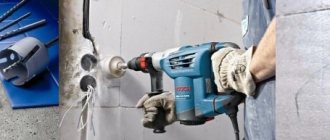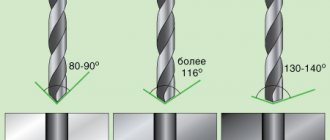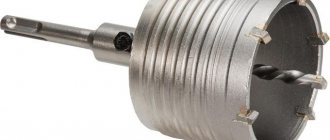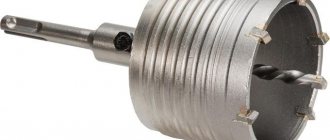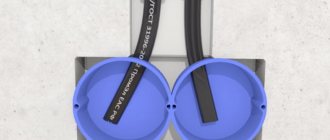How to drill concrete
wall
with an ordinary drill and hammer drill?
How to drill a concrete wall with an ordinary drill
? - this was probably the question that the craftsmen asked when they had to hang shelves, cornices, etc.
Concrete is a strong material and therefore can be drilled very poorly. Even how to drill a wall in a panel house seems an unsolvable problem.
Although, if you know certain secrets, this process will be greatly simplified for you.
How to properly drill a hole in a concrete ceiling
How to drill a concrete
wall with an ordinary drill and hammer drill? How to drill a concrete wall with an ordinary drill
? - this was probably the question that the craftsmen asked when they had to hang shelves, cornices, etc.
Concrete is a strong material and therefore can be drilled very poorly. Even how to drill a wall in a panel house seems an unsolvable problem.
Although, if you know certain secrets, this process will be greatly simplified for you.
Drilling concrete
Tools
To drill a reinforced concrete surface, you need to use specialized tools - in this case, you won’t be able to get by with a homemade tool.
Depending on your preferences and the diameter of the hole, you can use a hammer drill or a small electric hammer drill. The first option has less power, but at the same time has less weight and a convenient design. The hammer drill, accordingly, has greater potential, weight and dimensions.
Note! Since the use of construction equipment is often one-time in nature, it is more rational to rent them. Considering that their price is quite high, this way you will save a considerable amount of money.
In addition to the existing tool, it is necessary to purchase special drill bits that allow you to work with a concrete surface. For a hammer drill, drills with a Pobedit tip are selected.
The hammer drill has its own set of impact attachments, which, in most cases, are quite sufficient. As additional components for a hammer drill, you can also use drills with a tip.
To form holes with a diameter of 35 to 120 mm, crown bits are used, which have Victory teeth - with their help, grooves for sockets, switches, etc. are drilled. If you are wondering whether it is possible to drill concrete with a screwdriver, then there are also tungsten carbide coated bits for this purpose. However, it should be noted that they are only suitable for units with a power of at least 1 kW.
Preparation
Drilling
The process of drilling concrete is not particularly complicated and consists only of the ability to work with the tool. When working with drills, you should combine the hammer mode with drilling.
If you use crown attachments, the impact mode must be turned off. The only possible problem during this process will be the reinforcement frame reinforcement that may get in the way of the drill.
Before drilling reinforcement in concrete, you need to change the tip for working with concrete to a regular metal drill and drill through the obstacle. It is important to remember to turn off the bumper mode before drilling into the concrete.
In addition to the above, there are also a number of useful tips that will help you achieve quality results.
Diamond drilling
If you are thinking about how to drill through a concrete slab or create a large-diameter hole, then you cannot do it on your own. The most effective is diamond drilling of holes in concrete and cutting reinforced concrete with diamond wheels, which are carried out using specialized professional equipment.
The cost of installations is quite high, and purchasing them for single use is irrational. It would be wiser to invite specialists who provide their services at a very reasonable price.
The better to drill
As already mentioned, there are several ways to drill through a concrete wall; let’s look at each of them in more detail.
Hammer
When using a hammer drill or impact drill, they must be switched to impact mode, a working tool with a pobedite tip is inserted and it must be directed perpendicular to the wall surface.
If drilling holes takes a long time, then
periodically you need to wet the drill so that it does not overheat too much.
After you have drilled to the required depth, you must pull the working tool back without turning off the hammer drill . To clean the finished hole from dust, you need to deepen and pull out the drill several times.
A regular drill or screwdriver
If you do not have the tools described above, then this work can be done using a conventional electric drill or a powerful screwdriver.
Drilling will take more time than using a hammer drill, but you can do it yourself.
Peculiarities
Concrete structures are highly durable, so drilling them yourself is quite difficult.
This is due to the fact that crushed stone is used to create concrete products, and when you come across it while drilling, the process becomes very difficult.
The need to drill a concrete wall arises quite often; this is necessary for installing shelves, cabinets, air conditioning, gluing wallpaper, attaching a lamp, when attaching insulation, or when plastering walls to attach beacons.
There are several ways to solve this problem:
It should be remembered that for walls made of relatively soft materials, it is impossible to use pobedit drills, since the holes will be uneven and the wall will collapse. It is also impossible to work with metal with such a tool.
To create large-diameter holes or cut through a doorway, diamond-coated annular drills are used. To use such a tool, it is necessary to use special installations; they allow you to make holes with a diameter of up to 250 mm.
Since the cost of such equipment is high, it is easier to hire specialists or you can rent it.
Bosch Uneo
Cordless screwdriver capable of drilling masonry/making holes in concrete monolithic blocks/screwing screws. Tool Feature:
Diamond drills and other devices
Concrete rods have soldering along the entire length, which gives special strength. Even when working with hard materials, they retain their technical properties.
Externally, they are also different, which prevents them from being confused with others:
- a blunt end made of soldered pobedite, which is almost as hard as diamond;
- products are white, in contrast to black for metal and light for wood;
- the tip is wider than the shaft.
By design they are distinguished:
- screw - for drilling deep holes;
- spiral - for large diameter holes;
- flat - they make small holes.
The drills have a thickened shank and are snapped into the chuck.
If you need to drill a wide hole, but there is no hammer drill, a special attachment will help out. It's called a crown and has teeth that guide drilling into hard surfaces. They are made with diamond coating or from pobedit.
The cross section of the nozzles is 35-120 mm. A special demand for crowns with a diameter of 68 mm is the size of the socket boxes. Drill to a maximum depth of 150 mm, if more is required, extend it. The bits for hammer drills have soldered teeth, while those intended for drills have carbide coating instead.
This has some advantages: such a nozzle drills concrete and tile equally well, and highly specialized nozzles for a hammer drill have to be changed. The bit can be used with an electric drill with a power of more than 1 kW.
Various types of attachments are suitable for drilling:
- Impact bits with soldered teeth.
- Diamond - for hammerless drilling without a hammer drill. They have an abrasive on the edge; they work faster than impact hammers.
- KS crowns - with spraying on the edges.
High-quality products are offered by Bosh, Makita, Metabo, among domestic ones - Interskol, Zubr. Chinese products can also be of high quality if their price is high.
How to drill a wall without dust
To drill a wall with a hammer drill without dust, you will need two things: tape and a plastic bag, which are used for packaging.
It is preferable to use masking tape. Let's mark future holes on the wall in the right places. Place an open plastic bag under the mark on the wall with tape. It should be held in such a way that all the drilling dust falls inside it. You can drill carefully, the main thing is not to overdrive. Then the waste is poured into a bag.
As soon as you increase the speed of the hammer drill, some of the rot will be blown around by the air flow from the engine fan. If you hit it carefully, at low speeds, the process will go just fine. You will collect all the dust in a plastic bag. It can be used repeatedly.
An important point: the tape must be glued to the wall very tightly. Inadequate gluing will result in dust falling between the wall and the tape and staining the wallpaper.
Industrial methods of dust protection
Vacuum dust collector
This device comes in two types:
- Mounted on a wall or ceiling - under the influence of suction force, it reliably “sticks” to any surface, even textured, and stays there as long as the vacuum cleaner is turned on. It has a hole in the middle through which a drill or crown passes (by the way, the diameter of the hole can vary, but for household needs 6–7 cm is usually enough).
- Mounted on a drill or drill - initially placed as close as possible to the drill head, and as drilling moves towards the body. The disadvantage of such dust collectors is that debris can still spill onto the floor, albeit in small quantities. However, one cannot fail to mention their advantage - such devices can be used even if you have to drill into a wall in hard-to-reach places.
By itself, such a dust collector will be a useless toy. A prerequisite for its operation is the presence of a powerful vacuum cleaner connected to a special connection. You can drill once or twice using the same vacuum cleaner that is used to clean the apartment, but for regular use it’s worth getting a “Rocket”, “Whirlwind” or “Buran”. The fact is that fine dust seeps through the filter system and settles in the engine. Modern specimens cannot withstand long and burn out, but the old Soviet monsters are almost indestructible.
Self-adhesive bags
They have a number of advantages:
- They are relatively cheap, so they are ideal for those who use a hammer drill only occasionally.
- Doesn't take up space in your toolbox.
- Transparent, so they do not interfere with the view.
- Completely prevents dust from getting on the floor.
- There are options for both a regular drill and a hole saw.
- Despite the fact that they are considered disposable, after the first use they retain their adhesive properties and can be reused (you just need to empty out the debris that has accumulated inside).
The only disadvantage of such packages is that they are completely unsuitable for drilling ceilings and other horizontal surfaces.
Drill bit
It looks like a cone that fits onto a drill. At first it is straightened out to its full length (the wide end rests against the wall, and the narrow end rests against the body of the drill), but as the drill moves deeper into the wall, it folds like an accordion. When using a drill with a long shank, you have to press the bit against the wall with your hand, which can be inconvenient.
Disadvantages when using a vacuum cleaner
Some people use a vacuum cleaner. This is a good option to avoid dust when drilling with a hammer drill, but not always acceptable. This device may not be at hand. It requires two people to operate it. One drills a hole with a hammer drill, the other holds the suction tube of the vacuum cleaner next to the working part of the drill. All dust is sucked into the vacuum cleaner. But you can’t handle this situation alone. It is inconvenient for one person to monitor two operating devices at the same time, holding their parts in the right places.
Crazy Hands Method
Although the ancient invention offered for review has lost its relevance, in some extreme situations it can still be useful today, when you need to drill a hole without using a drill, which is simply not at hand. The authors of the program Crazy Hands suggest making an ancient instrument from new materials.
By the way, in another article, read about a device that can help you improve your work with a drill.
What do we need to create a hand drill?
– ballpoint pen with edges; – drill; – jar lid; – weights (nuts or other); – wooden plank; - rope.
How to make a hole in a suspended ceiling with your own hands
Making a hole in a suspended ceiling with your own hands is not as difficult as many may initially think. The algorithm for the work performed depends entirely on the purpose for which the hole is to be made. As practice shows, the most common reason is the installation of a chandelier or a bypass for a pipe. All that is required in this case is to make a mark on the surface of the ceiling, install a special plastic ring and cut a hole of the required size with a sharp object. If necessary, you can watch the video and familiarize yourself with the step-by-step algorithm visually.
Where does dust come from?
As a rule, hard materials are drilled with a hammer drill or impact drill. A drill, drill bit or other tool destroys the material and brings small particles to the surface. There is a special impeller inside the power tool. Rotating, it drives cold air towards the cartridge, cooling the engine and preventing the mechanism from clogging. However, the air flow disperses the dust to the sides, lifting it into the air.
Depending on the nature of the material, the dust will be more or less coarse. Homogeneity also differs: particles can have the same size or form several fractions.
Step-by-step instruction
How to make a hole in a concrete wall or ceiling slab without a hammer drill and other similar tools?
First you need to prepare everything.
Despite the presence of a special drill, work on a concrete wall is carried out taking into account the recommendations of specialists.
An incorrect approach can lead to tool breakage and partial destruction of the wall. Before starting work, prepare the following set of tools and materials:
The process of drilling concrete with a conventional drill is not fast, so the home craftsman should be patient. Concrete dust eats into the floor covering, and to maintain cleanliness, it is recommended to cover the surface with newspapers. Periodically collect spilled particles with a vacuum cleaner. The sequence of work is as follows:
IMPORTANT. Each drilling stage should last no more than 30 seconds. The total duration of continuous drilling with a low-power tool is no more than 10-12 minutes. The motor of the tool must be cooled after each session, otherwise it will overheat and fail.
Drilling concrete with a diamond crown can be seen in the video:
In the video, the author explains how to drill concrete without impact:
Safety precautions
Any construction or repair work is associated with certain risks, so it is important to know how to drill concrete without injury. A number of rules must be followed:
First you need to check that there are no pipes or electrical wiring in the drilling area. This can be done using a metal detector. If possible, turn off electricity in areas where repairs are being carried out. The drill is connected to a separate socket connected to the distribution panel. The metal detector may not recognize pipes or wiring under a decorative coating.
Drilling in such places must be done with caution so as not to unnecessarily damage the wall. If the house has hidden gas wiring, then the gas must be turned off during the work. It is strictly forbidden to drill seams in a block house. Communications are often laid in the channel between blocks in violation of building regulations. Be sure to check how the drill is secured in the chuck. During the drilling process, it is necessary to use protective equipment: glasses, gloves, special clothing
If you plan to work at height, wear a hat. Drilling produces a lot of dust. A protective mask or respirator must be used. When drilling through a wall, you must make sure that another person is not working on the opposite side. If the hole needs to be made at ceiling level, then the work is carried out not from a stepladder, but from scaffolding or a trestle. The stepladder is less stable. If there is no suitable support, then the stepladder is strengthened with stops. Do not turn on a tool that rests on the work surface. The pressure and speed increase smoothly.
- To ensure stability of the tool, it is held only by the handles. Holding a working drill by the chuck is strictly prohibited.
- In some regions there are legally set times during which noisy work cannot be carried out. This must be taken into account when drawing up an action plan.
To gain the skill, you need to drill a hole in concrete several times slowly and carefully. This will help you understand that if you follow the nuances and safety precautions, this work does not cause major problems and difficulties. Even beginners can do it on their own.
Types of drills for concrete - what are they?
How to groove a wall for wiring without a special wall chaser
How to properly paint a plastered wall with water-based paint
Sealing through holes and holes from hardware in a concrete wall
Hole for installing chandelier
There is no need to pre-prepare the embedded products, because the chandelier will be fixed on a hook, which is located in the concrete ceiling. You can make a hole for installing a chandelier yourself, without turning to a specialist.
In the required area, you should glue a plastic strip that fits in size. It should be transparent or match the shade of the structure. Then, when the plank is well glued, you need to make a cut in the film and remove the trimmings. Then, through this hole, you can drill a hole in the ceiling for the dowel and install a hook for the chandelier.
Required knowledge
First you need to find out how the ceiling will react to a puncture. It all depends on what type of stretch ceiling is used in your case, that is:
Option 1.
As a rule, difficulties with punctures and cutting arise with polyvinyl chloride film sheets. The fact is that polyester is “afraid” of punctures. But if the fabric is properly tensioned, then after the puncture it will not unravel.
Official instructions from some manufacturers inform us that the material allows you to safely install lamps without fear that the hole will spread further. Therefore, you can also screw in a self-tapping screw without fear.
Keep in mind that luminaires in tension systems are mounted in specially prepared places. There should be a solid platform where screws or other fasteners will be screwed in. If there is a need to install additional lighting fixtures, which was not initially planned, you will have to remove the canvas and then install a platform for screwing in the fasteners. No other way.
Option #2.
With vinyl films the situation is somewhat different. Here a puncture/cut will render most of the fabric unusable. Therefore, all holes in it are made using special technology. Its essence is to strengthen the material around the work area - an o-ring seal is glued.
To do this, you can use both factory-made and homemade plastic rings, and glue suitable for PVC. Now let's talk about how to prevent unintentional tearing and keep the ceiling looking attractive.
Tips for using rotary hammers
There are several rules for using rotary hammers that must be followed.
During operation, do not press too hard on the tool to prevent damage to the drill. In any case, this will not increase power and performance. A common mistake is the desire to complete the entire operation in one go. The drill needs to be cleaned periodically. The choice of equipment is determined by the type of work performed and the specific features of the tool itself. For example, when using one type of hammer drill, you will need an adapter to replace the nozzle, while the second has a quick-release design. Mechanical damage or systematic overheating of equipment is not allowed
When choosing, you should pay attention to models with an aluminum case, which, due to the characteristics of the material, always cool better. When working with a hammer drill, it is recommended to wear rubber gloves, which will help dampen vibration, despite the fact that the tool itself is equipped with special inserts for this purpose.
It is important to find out: “TOP 5 drill manufacturers: which company is better”
Making a hole in the finished ceiling
If the ceiling is already stretched, and you decide to install additional lamps, change their location or replace them with others, you can do it yourself. If the installation of the stretch ceiling was installed by a professional company and it is still under warranty, call a company employee to clarify the details. In some cases, creating holes in tension structures will void the warranty. If you did the installation yourself, such problems do not concern you.
The hole is made in different ways. Choose the one that suits your case. One of them is suitable for installing an additional chandelier or lamp. The operating principle is as follows:
If you plan to place the chandelier on a hook, you do not need to remove the canvas. It is enough to glue the rings in the specified places and cut out the holes after drying. The hook is attached to the base ceiling using dowels. It is recommended to use a hammer drill to create holes for fasteners.
Cutting a hole in a ring
Remember that the maximum power of the lamps that you have chosen for the stretch ceiling should not exceed 50 Watts. If you omit this point, the structure is unlikely to last long while remaining aesthetically pleasing.
The second option will be useful for those who plan to create a hole for draining water. To do this, turn off the power to the wiring and carefully drain the water through the holes for the lamps using an ordinary hose. If there are no such holes, release one of the corners of the canvas and get rid of the liquid. After this, the film itself will take its original appearance.
Rings for creating holes for lamps
Jig for drilling holes without dust
Due to the heterogeneity of the walls, especially those made of brick, the drill often “leads” away from the intended place and if there is more than one hole, then the suspended shelf does not hang horizontally or, even worse, it is impossible to hang it, since the installed dowels do not coincide with the mounting ones loops. You can use a jig in the form of a sheet of plywood with a pre-drilled hole, but when drilling due to vibration it can also move and again the result will not be what was expected. But there is a simple technology that allows you to drill two or more holes strictly in specified locations.
Precise hole drilling
It turns out that the problem can be solved very simply by gluing a sheet of any sandpaper with glue or double-sided tape to the entire area of the side of the conductor that is attached to the wall. At the same time, the adhesion of the jig to the wall surface increases many times over, and during drilling, the specified accuracy of positioning of the jig is ensured. The hole will appear exactly at the marking location.
Depending on the weight of the product and the density of the wall, you have to drill holes for dowels of different diameters, usually 6 or 8 mm. For the versatility of the jig, it is necessary to drill several holes of the desired diameters with an ordinary drill.
To top it off, attach a plate to the end of the base of the conductor at a right angle. Thanks to this modification, most of the drilling products will remain on this shelf, which will prevent contamination of the wallpaper and reduce the scattering of dust in all directions.
The proposed device is also indispensable when drilling holes for attaching skirting boards. Drill a hole in the jig at a given height from the shelf. When drilling, place the shelf on the floor and all the holes will be exactly at the required height from the floor, which will guarantee a tight fit of the plinth to the floor surface.
Sometimes you have to hang a product on the wall, for which you need to drill several holes in the wall and maintain the distance between them with greater accuracy. If the wall is brick and plastered, then it is impossible to perform accurate drilling without a jig.
To make a jig for precision drilling, a board, sheet of plywood or metal is suitable. After marking, the required number of holes is drilled in the sheet using an ordinary drill. Consider the case for fastening the product with two screws. One hole is drilled with a diameter equal to the diameter of the drill that will be used to drill the wall, the second with a diameter equal to the diameter of the self-tapping screw. After the jig is made, the first hole is drilled in the wall using the jig for the precision drilling described earlier, and a dowel is driven into the hole.
The jig is screwed to the wall using a self-tapping screw into the hammered dowel and leveled using a water level so that the drilled holes are on the same horizontal plane.
Thanks to the use of a simple jig, which can be made in a few minutes from any available material, the holes were created exactly at a given distance from each other.
Using the same technology, you can drill a whole series of holes at a greater distance from each other. In this case, first the outer holes are drilled using the technology described above, the jig is screwed with two outer self-tapping screws, and then all other holes are drilled.
The proposed options for conductors are convenient when renovating an apartment, when dirt is common everywhere. However, when the renovation is completed and cleaned up, drilling becomes stressful. You don’t want to stain your carpets and furniture with concrete or brick chips and dust.
Application of dust collector
You can make a dust collector yourself. You need to use a paper or plastic cup, make a hole in the bottom and put it on the drill. Dust and fine particles from the ceiling will fall into the glass.
You can make a paper funnel. It is fastened with tape, the sharp part of the cone is cut off and also attached to the drill using tape, above the drill mount. The disadvantage of these methods is that dust still blows around the apartment, albeit in much smaller quantities.
You can use half a children's rubber ball as a dust collector. The principle of fastening is the same as with a glass. You just need to be careful when working with such a dust collector so as not to inadvertently smear the rubber ball on the ceiling - it may leave a mark.
A vacuum cleaner will catch dust from drilling the ceiling well. There is a nuance here: in order to do quality work, you can’t do it alone. You definitely need an assistant who will hold the vacuum cleaner hose in close proximity to the drilling site.
Why fight dust?
Dust is undesirable for many reasons:
- When dust enters the body, it causes health problems.
- Particles of cement or brick flour, getting into the gears of mechanisms, can damage them.
- When mixed with water, cement dust forms dirt that is difficult to wash off.
However, all these measures only reduce the damage. Devices that collect dust even as it forms can radically solve the problem.
Professional builders have in their arsenal a special tool to combat the resulting flour: an attachment on a drill or drill, to which a hose from a vacuum cleaner is connected. This addition to the hammer drill helps collect garbage very cleanly, but it has a number of disadvantages:
- You have to spend money to purchase a nozzle. Such expenses are appropriate if you have to drill constantly. But if you occasionally have to drill one or two holes in the ceiling or wall, it is irrational to buy a special nozzle.
- As a rule, using the nozzle requires the help of a partner who will hold the vacuum cleaner. In everyday life, improvised do-it-yourself devices are used to solve the same problems.
How to drill into a concrete wall
A concrete wall is a very strong structure, so it is difficult to process. But in order to install mechanical fasteners, it is necessary to drill the surface. If you don't have the appropriate equipment at hand, it will be difficult to cope with the task. Based on what the hole is being made for, you should use the working part of the tool of a certain diameter. Depending on this parameter, you can hang everything on the wall - from a mirror to heavy pieces of furniture.
Drilling concrete can be carried out with the simplest equipment or a special machine. In the first case, we are talking about a drill, which may have an impact function, which will simplify the work process. You can make the largest hole in a concrete wall using diamond drilling. But such equipment is expensive, so it is usually used only by professionals.
While drilling you hit a piece of wood
Sometimes, strange as it may seem, you can find wooden blocks inside concrete walls. If, when drilling a concrete wall, you hit a piece of wood, then the situation is similar to the situation when you hit reinforcement. Simply change the drill from a concrete drill to a wood drill.
Here the case is simpler, because the wood is soft and you will drill through the block very quickly. How to understand that it is a piece of wood? Firstly, the drill will also stop quickly going into the concrete. Secondly, there will be a specific sound, different from the sound of drilling concrete and clanging on metal in the case of reinforcement. Thirdly, when intensively drilling, as they say, in one place, you may smell a burning smell (the wood will become very hot from the drill).
To get acquainted with this sound and these sensations, just try drilling a wooden block with a hammer drill and you will understand everything.
The most suitable way
You must decide what is best for drilling into concrete walls. Often a conventional drill is used. It is convenient if it is two-handed, which will facilitate the process, because the master will need to put in a lot of effort.
If large-scale work is planned in the apartment, then you can drill the wall using a hammer drill. To make holes of impressive diameter, it is worth taking a motor drill. Its power should start from 5 kW. There are no such household models, so such a device cannot be powered using a single-phase network.
Hammer
The efficiency of this tool is quite high due to the chiselling option, but this equipment is more expensive than an impact drill. When you are thinking about how to drill a concrete wall, it is recommended to consider a hammer drill, which uses the principle of rotation and reciprocating movements of the working part, which speeds up the task. It is better not to drill cellular concrete this way, because it is completely destroyed under such influence due to its fragility.
When the surface of regular concrete has a plaster finish, care must be taken when making holes to ensure that the finish does not crumble. In order to drill holes in concrete, in addition to the tool, you need to use special drills with a diameter of 4 to 8 cm. In order to eliminate unnecessary expenses, you need to select the drill diameter according to the corresponding dowel parameter.
Household drill VS screwdriver
When thinking about the question of how to drill a concrete wall in an apartment, you can choose a drill. The result and safety of the equipment depend on how correctly the drill is chosen. Consumables with triangular tips are recommended. It is better if they are made of carbide metal. The drill may get stuck and no longer advance. In this case, you need to temporarily work with a punch.
When thinking about how to drill concrete with a screwdriver, you should take care not to damage the tool. The solution may be more powerful technology. But when suitable equipment is not available, you can try to carry out the work with the tool that is at hand. Additionally, a hammer and a punch are used.
The drill must be designed for working on metal. But you should be prepared for the fact that after such manipulations it will no longer be suitable. When you have to drill concrete without a hammer drill and only using a screwdriver, it is good if the equipment has an impact function. In addition to the model, you need to use equipment with a carbide working part for bricks.
Diamond drilling
The most effective way to drill holes in a concrete wall is by using diamond drilling. The peculiarity of this work is that you can even move at an angle. You can immediately begin installing socket boxes or other devices. Very little dust is generated. The main disadvantage of such drilling is the sometimes prohibitive price of equipment and the impressive cost of the work itself.
Preparing for work
The easiest way to drill holes in concrete with your own hands is with a hammer drill or impact drill. Such tools will allow you to drill a concrete surface with reciprocating blows of the drill used, and remove the resulting crumbs by rotating it.
Performing such work with a conventional drill in concrete is slower and more difficult than in wood or other soft materials.
- When purchasing a tool, it is better not to save money, but to give preference to a well-known brand;
- The adjustable rotation speed of the tool must be taken into account;
- Determine the drilling depth of a possible hole;
- Find out the ease of performing the work with the equipment;
- Safety precautions must be observed. To do this, you should wear safety glasses to protect your eyes from concrete chips, use earplugs to avoid damaging your hearing, and purchase work gloves to protect your hands from working with a drill. When carrying out long-term work, it is recommended to use a respirator;
- High quality concrete drill bits should be used for drilling. They should be with carbide tips and designed specifically for impact drills that can withstand the stress of impact drilling in strong concrete;
Tip: A tool for drilling holes in concrete must have a length of working part with grooves no less than the depth of the hole that needs to be drilled. These grooves are needed to remove dust generated from the hole.
Classification and features of concrete drills
When you have figured out whether it is possible to use all kinds of devices, including a drill, to drill through concrete, you should become more familiar with what features drills have. All of them usually have carbide tips, which provide strength to the material and products. Such consumables are called pobeditovye and can be intended for a drill or hammer drill. In the first case, the equipment has a multifaceted or cylindrical configuration.
Using the first one, you can drill concrete to an impressive depth. If it is necessary to make holes of impressive diameter, you should use a second type drill. If you need to drill a concrete slab to a small depth and diameter, you need to purchase a flat consumable.
Many people think about whether it is possible to make holes with a diameter of up to 100 mm or more. The answer is yes. If you are also one of those craftsmen who set themselves a similar task, you should purchase a crown, which may have a diamond coating or a pobedite cutting part.
Attention! When drilling holes in concrete, you will need to choose a specific diameter of tooling. As this parameter increases, the length of the drill will become longer. This is due to the fact that a thin and long consumable will not be able to withstand impressive loads.
Cutting elements for concrete processing
To make holes in reinforced concrete blocks, it is necessary to use special drills, they are called pobedit drills. The tip of such a tool is coated with carbide coating. There is no point in saving on drills; a cheap tool will quickly fail at the most inopportune moment. You can drill concrete correctly only with special cutting elements designed for this purpose. Diamond-coated drills are also used. They are installed on special drilling rigs that create large holes with a diameter of 200 mm.
To arrange connectors for a switch or socket, crowns are used, which are a scaled-down model of diamond drills for drilling rigs. As a rule, their diameter is from 35 to 120 mm. Crowns allow you to drill holes up to 150 mm deep. When installing such an attachment on a hammer drill, you need to turn off the impact mode. Among the drill attachments there are similar bits. Their advantage is that they can be used to process several different materials. At the same time, drill bits are designed for devices with a power of at least 1000 W.
Work algorithm
If you are interested in knowing how to drill concrete, you should familiarize yourself with the work algorithm. At the first stage, you need to mark with a pencil. The tool is brought to the surface and is well held with the help of one or two handles.
If you are using a drill, first set it to low speed. In order to drill through the material, you can first make several short inclusions. This recommendation is valid if the tool does not have a speed control option. Already at this stage you can get a recess of about 3 mm. This will allow you to adjust the direction of the tool.
Attention! Once you know whether you can drill holes with an impact drill, you may have more questions. For example, how to drill concrete in such a way that you get holes of impressive diameter. The answer is simple: you need to start drilling with smaller diameter drills. This will ensure the stability of the device.
At the next stage, drilling continues in impact mode. The equipment must be held strictly perpendicular to the wall. Many people wonder whether it is possible to drill into a concrete surface by pressing too hard on the tool. This is not necessary, as the equipment will undergo high loads and may fail. Every 10 seconds the device should be removed and again immersed in the hole in the concrete wall.
Do not forget about cooling the engine, especially if you are working with a household device. In order to drill through material with hard inclusions, you should additionally use a chisel. You need to tap it a little with a hammer, inserting the first tool into the hole. If you are wondering how to drill into a concrete wall with rebar, you should know that if the tool collides with iron, you must stop immediately until the obstacle is removed.
Tool preparation
Before you drill into a concrete wall, you need to make sure that you have the appropriate electrical equipment in place. You need to make sure that you have drills available that are designed for working with concrete. They must have the correct diameter.
If you have to drill a reinforced concrete wall, you should work not only with concrete equipment, but also with metal. The drilling mode is unlikely to achieve a positive result, at least in the short term. When concrete is to be drilled with a drill, you should select consumables with carbide tips. With their help, you can get rid of accumulated debris in the hole.
A little about the structure of the drill and installation of the drill
If you want to know how to properly drill a concrete wall, you should also familiarize yourself with the design of the tool. It is based on an electric motor. It provides for:
The design also includes a rotor. This is the shaft where the core is installed. Along its length there are grooves for armature windings.
Every master who has at least once encountered repair and construction work can say: “I can drill a concrete wall.” How this can be done is a rather broad question. If you want to use a drill, it is important to know how to install the drill bit into it. It is placed in the cartridge and fixed taking into account the design of the latter. After these procedures, you should make sure that the equipment does not wobble and is installed without play.
Latest developments or old classics
Before drilling a hole in a concrete wall, you should figure out which tool to use - new or old. The latest developments are not always more advanced, but this does not apply to equipment for working with dense materials. If you are still concerned about the question of whether it is possible to make a hole in a wall with a screwdriver, you should know that although the answer is positive, experts do not recommend using this tool.
When an old model of any device is available, it is better to replace it with a new one, but you should not save money by choosing equipment with a shock function and a reverse option. This will allow you to drill through concrete as efficiently and quickly as possible. And if the drill gets stuck in the reinforcement, using the reverse movement function of the equipment, you can easily remove it from the thickness of the material.
Selecting power for a drill
You know how to drill concrete with a drill. Now you need to also ask what power the model should have. If you are just purchasing a device, you should not even consider models under 500 W. They are only suitable for soft materials. But if the power is 1000 W and below, such a device can already cope with a solid wall.
Difficult areas
You know how to drill into concrete correctly, but that's not all you need to know when it comes to difficult areas. In these cases, it is better to use a hammer drill. But if it doesn’t fit, a hand chisel is used. This device will allow you to crumble hard layers.
Large diameter holes
My readers' experience
Tip 1
Half-mask respirators are complete rubbish. Spraying water does not clear the air of fine—the most dangerous and most volatile dust. If you have a partner and the opportunity, to reduce the FORMATION of dust, try spraying the grinder disk on the place where it fits into the groove being cut. Since pneumoconiosis is incurable, use RPE that is more effective than half masks (in order of increasing effectiveness): full-face masks with P3 filters (BUT so that the size matches your face), and they also have forced supply of clean or filtered air under the mask (so that unfiltered air did not leak through the gaps between the mask and the face - the main problem of RPE). The second option is more expensive, to put it mildly. The compromise is to work intermittently, tightening the headband fastening straps (to press the full face mask tightly against the face). In industry they use ventilation, but this is unlikely to suit you. Although drilling in the ceiling with a vacuum cleaner in one hand and a drill in the other is quite possible.
Tip 2
It was an experience. The apartment is residential. Renovation only in the kitchen. I moved the sockets, chiseled the walls (concrete) with just the same diamond disc as you have in the video, concrete with stones. Goal: to protect the apartment from dust; it is clear that in the kitchen itself there is a column of dust.
Option 1. Hang 2 sheets of dense polyethylene on the door with a large overlap of the wings vertically, with the ability to connect them with Velcro or a zipper. This option was prompted by the mobile chemical laboratory system. Polyethylene - so that dust rolls down. Dense - to walk on, so as not to tear. Velcro - to protect the passage and the gap in the middle. Apply tape around the perimeter of the door jamb. We didn’t get around to Velcro (there was no one to sew), and since the polyethylene is dense, the gaps still remained. I declined this option.
Option-2: The idea is the same, but instead of polyethylene I used 2 wet sheets, the tape around the perimeter of the door fell off by itself, and was replaced by nails and buttons. The overlap on the walls along the perimeter is 20-30 cm, in the middle of the passage it is also about 30 cm. Before dusty work, I removed it, wet it generously, and as it dried, sprayed it with a flower spray bottle. At the bottom, along the width of the door, I laid a wooden beam, pressed the sheets, provided tension, and thereby plugged the bottom gap. The main thing is that there is no draft in the apartment; all windows must be closed. At the end of the work (when the dust is thick and you are there), breathing all this goodness is harmful. I tried to spray the air to knock down dust, but the effect is weak + dirt appears. Additionally, he opened the window in the kitchen, put a fan opposite it to blow it out and went through the “wet barrier” into another room, waiting for the dust to settle. Result: dust seeped from the kitchen into the corridor and settled on the floor at a distance of about 3 meters (this was helped by the natural convection of air in the apartment), but beyond that there was no obvious dust. Daily cleaning of the corridor in the evening saved me from the displeased glance of my wife. Of course, and without fail, any renovation requires cleaning the entire apartment; dust appears always and everywhere. I hope someone will find my experience useful.
So, today we learned what construction dust is, where it comes from, and in what cases it occurs most often. How to protect your respiratory organs from it, how to work, protecting your furniture and other valuable accessories from it in the house.
